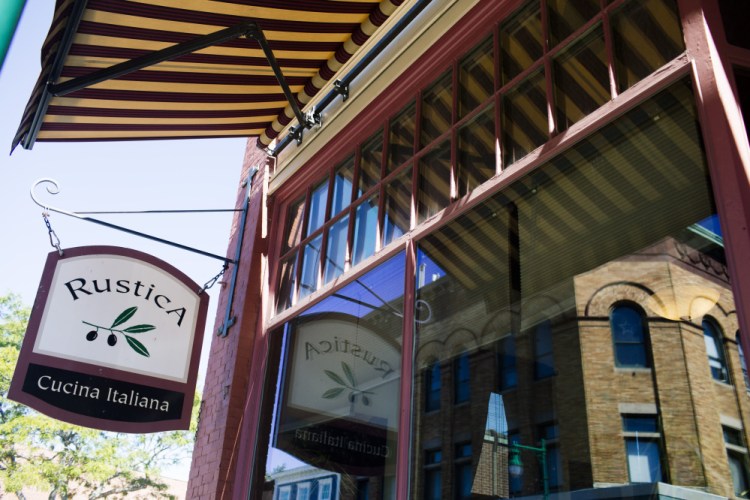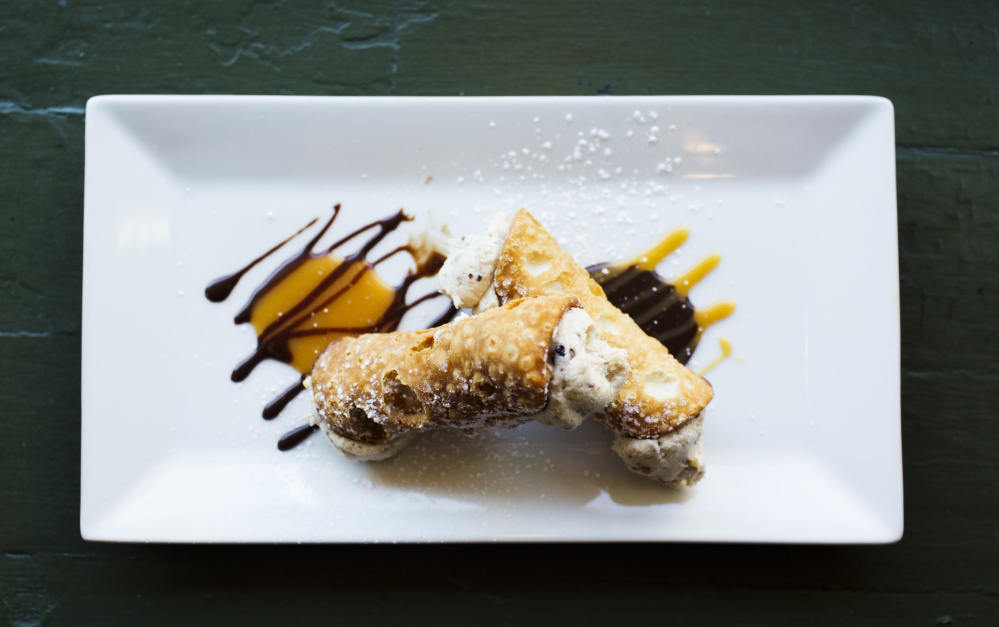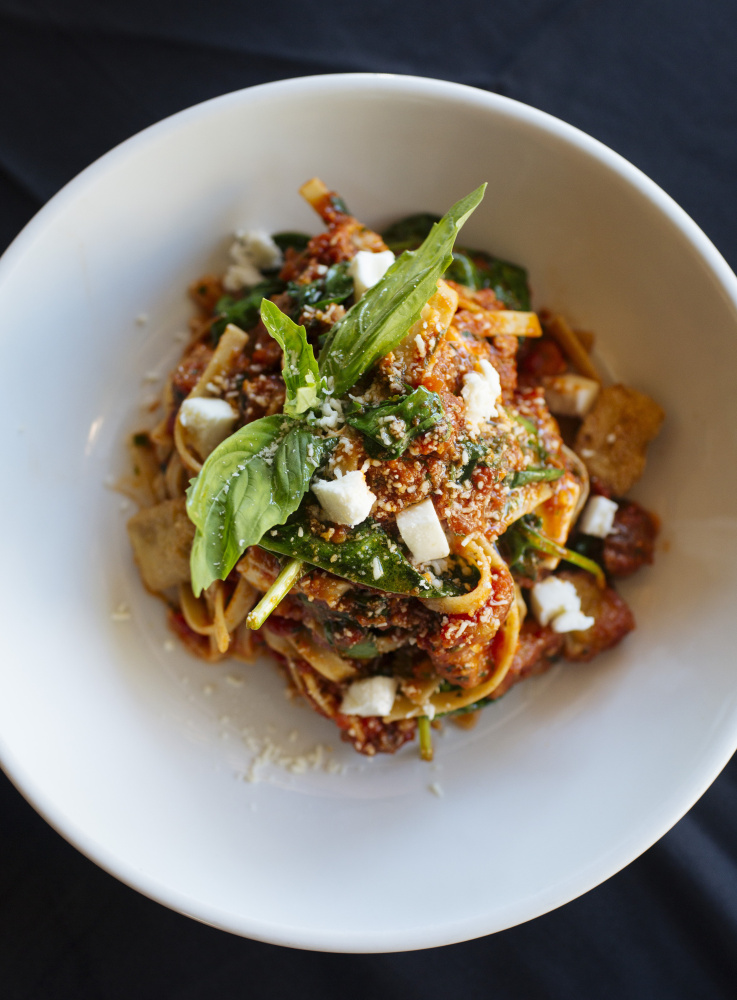Restaurant names run the gamut. Some are pretentious, many are eponymous, a few become iconic (think Chez Panisse), and others remain purely descriptive. Rustica Cucina Italiana in Rockland falls into that last category. Chef John Stowe’s rustic kitchen serves enormous portions of hearty, familiar Italian and Italian-American favorites that are flavorful, satisfying and so filling you’ll likely have trouble cleaning your plate. If you’re exercising restraint, look elsewhere. Rustica is all about more.
“I don’t do foams, I don’t do pillows that pop, and I don’t do the understated kind of dishes you find in Italy,” Stowe says. “I think the American palate is looking for more… And if the portions seem large, you can always take the rest home and eat it for lunch.”
The dining room is large and loft-like, with a high ceiling (painted black), exposed pipes and brickwork, and polished wooden floors. Even on a weeknight it seems to fill quickly – and early. Rustica opens at 5 p.m. and by 5:30 p.m. many of the two-tops are already occupied.
Stowe never attended cooking school, but worked at Italian restaurants in Connecticut and California, then served as chef aboard the Kathryn B, a three-masted schooner that sailed the coast of Maine in the summer and the West Indies each winter. The key to his food is intense flavor: He uses generous amounts of citrus or aromatics to enhance the flavor of virtually everything he prepares.
If you think that field greens are predictable and boring, try Rustica’s artichoke salad ($8). A combination of vibrant baby greens, orange segments, shaved fennel, toasted pine nuts and fried artichokes, it’s dressed lightly in a bright dressing made with champagne vinegar, garlic, orange juice and orange zest. Stowe reduces the orange juice before adding it to the dressing, and you can taste the extra burst of flavor that this delivers. What keeps the vinaigrette so light? “I use more juice and more vinegar and much less oil than normal,” he says. The salad has been on the menu since Rustica opened in 2006, but remains so popular that Stowe has given up any thought of replacing it: “Customers would kill me.”
Roasted baby beets ($8.50) are served with a mascarpone cream enhanced with more citrus, this time lemon juice. The cream is cool and tart and melts quickly on the tongue, a delicious contrast to the roasted beets, which release a concentrated sweetness with every bite. This appetizer arrives with a salad of peppery arugula drizzled with a syrupy balsamic reduction, but really needs no accompaniment. The beets and cream are delicious on their own.
Stowe makes his hot Italian sausage in-house, and it’s heaped into a pasta bowl with fettuccine, crispy eggplant, mozzarella, basil and fresh spinach, then covered with a zesty house-made marinara sauce ($18). (Some tomato sauces, even those made with fresh tomatoes, taste unpleasantly sweet when too much sugar is used to tame the acid in the fruit. At Rustica, the kitchen relies on chunks of onions, sweating them down until they release their natural sweetness; they become a base for the classic red sauce.) This marinara was deeply satisfying and the pork sausage was a delicious surprise, “substantial, but not at all fatty,” a friend described it. But the panko-coated, deep-fried egg- plant was another story. A prolonged plunge in the marinara sapped the cubes of flavor and left them spongy. Oh well. I didn’t go hungry.
The risotto special with blue cheese, Portobello mushrooms and thinly sliced sirloin ($21) proved an amped-up American version of the classic Italian dish. Rustica’s risotto was creamy, redolent of onions, and rich with the taste of butter, melted blue and handfuls of Parmesan. A paper-thin shaving of beef from the bowl tasted tender and meaty. So did the large slices of mushrooms, which had absorbed the flavors of the stock to develop their own earthy, distinctly beefy flavor and fragrance. Rustica’s serving of risotto was ample – no, enormous (the word abbondanza sprang to mind) – and it was compulsively good.
In keeping with the rest of the menu, Rustica features familiar New World desserts (upside-down cake) and Old World favorites, like tiramisu and cannoli. The night we visited, the cannoli were filled with a blend of ricotta and mascarpone and flavored with an enthusiastic squeeze of lemon plus hints of ginger. They failed to live up to the rest of the meal; the filling was grainy and the shells – though house-made and rolled through the restaurant’s pasta machine – were tough. Either the thickness, or the baking time, required some attention.
And so did elements of the service at Rustica. While the staff were unfailingly polite, they occasionally seemed untrained. Our waitress offered pepper from a grinder set somewhere between coarse-as-you-can-get and positively nuclear: A more experienced server would have adjusted it before we had to stop her. And when our table was cleared, the server stacked our plates and silverware into a large pile, a technique that may pass muster in a school cafeteria (or at home) but not in a white-tablecloth restaurant.
Minor stumbles notwithstanding, Rustica has a great deal going for it. The space is inviting, the Italian-style food is comforting and familiar and the portions are beyond generous. The Oxford English Dictionary defines the word rustic as “plain and simple…having the charm of the country.” Rustica is well named.
James H. Schwartz has covered food, travel and architecture for The Washington Post, Downeast, Coastal Living and Southern Living magazines for more than 30 years. Long a commuter between Portland and Washington, D.C., he retired from his job as vice president at the National Trust for Historic Preservation in 2013 and relocated to Maine.
Copy the Story LinkSend questions/comments to the editors.





Success. Please wait for the page to reload. If the page does not reload within 5 seconds, please refresh the page.
Enter your email and password to access comments.
Hi, to comment on stories you must . This profile is in addition to your subscription and website login.
Already have a commenting profile? .
Invalid username/password.
Please check your email to confirm and complete your registration.
Only subscribers are eligible to post comments. Please subscribe or login first for digital access. Here’s why.
Use the form below to reset your password. When you've submitted your account email, we will send an email with a reset code.